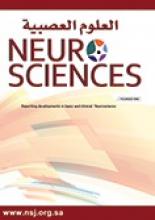Article Figures & Data
Tables
Characteristics Group 1 Group 2 P-value Number of patients 51 135 NA Postoperative CSF Leak 1 (1.9) 7 (5) 0.3* Complications 7 (13.7%) 21 (15.5) 0.72 LHS (mean±SD) 4.7±1.9 years 2.7±2.4 years <0.001 Functional 7 (19) 62 (45.9) <0.001* ↵* Fisher exact test due to chi square assumption violation, CSF - cerebrospinal fluid, LHS - Length of hospital stay
Histopathology n (%) Non-staining adenoma 41 (23.5) Prolactin-producing adenoma 26 (14.9) FSH-producing adenoma 21 (12) LH-producing adenoma 1 (.5) GH-producing adenoma 19 (10.9) ACTH-producing adenoma 21 (12) GH-, prolactin-producing adenoma 6 (3.4) FSH-, LH-producing adenoma 12 (6.8) Alpha-hCG-producing adenoma 3 (1.7) ACTH-, LH-producing adenoma 1 (.5) FSH-, alpha-hCG-producing adenoma 7 (4) Alpha-hCG-, FSH-, LH-producing adenoma 7 (4) TSH-, alpha-hCG-, prolactin-producing adenoma 1 (.5) TSH-, alpha-hCG-, GH-producing adenoma 1 (.5) FSH-, LH-, Atypical WHO II-producing adenoma 1 (.5) Not specified adenoma 2 (1.1) ACTH-, FSH-, GH-, prolactin-producing adenoma 1 (.5) TSH-producing adenoma 1 (.5) Spindle cell oncocytoma 1 (.5) Corticotroph cell hyperplasia 1 (.5) TSH - Thyroid Stimulating Hormone, LH - Luteinizing Hormone, HCG - Human chorionic gonadotropin, FSH - Follicle Stimulating Hormone, ACTH - Adrenocorticotrophic hormone, GH - growth hormone
Patients Treatment 1 Conservatively, by lumbar drain 2 Conservatively, by lumbar drain 3 Conservatively, by lumbar drain 4 Surgical repair 5 Conservatively, by lumbar drain 6 Surgical repair 7 Conservatively, by lumbar drain 8 Conservatively, by lumbar drain Reasons Group 1 Group 2 n (%) CSF leak 1 (1.9) 7 (5) Nasal bleeding 1 (1.9) 1 (0.74) Bradycardia None 1 (0.74) Hemodynamic instability None 1 (0.74) Electrolyte abnormalities None 2 (1.4) Headache 2 (3.9) None Deep venous thrombosis None 2 (1.4) Wound infection* 1 (1.9) None Sinusitis None 1 (0.74) Intracranial bleeding None 1 (0.74) Pulmonary embolism None 1 (0.74) Urinary tract infection None 1 (0.74) Subdural hematoma None 1 (0.74) Visual loss† 1 (1.9) 1 (0.74)‡ Hematuria§ None 1 (0.74) Cardiac arrest None 1 (0.74) Diabetes insipidus None 10 (7.4) Thyroid storm None 1 (0.74) - Table 5
Histopathologic subtype and other variables in group 2 patient with postoperative CSF leak.
Patient Sex Histopathology Functional 1 F Adenoma, alpha subunit No 2 F Adenoma, FSH, alpha-hCG No 3 F Adenoma, ACTH No 4 M Adenoma, non-staining No 5 F Adenoma, ACTH, FSH, GH, prolactin No 6 F Adenoma, FSH No 7 F Adenoma, non-staining No TSH - Thyroid Stimulating Hormone, LH - Luteinizing Hormone, HCG - Human chorionic gonadotropin, FSH - Follicle Stimulating Hormone, ACTH - Adrenocorticotrophic hormone, GH - growth hormone






